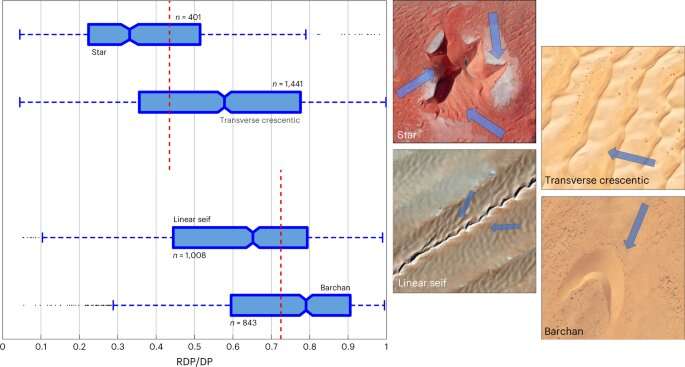Phase diagram of desert dune types as a function of directional variability in sand drift. Credit: Nature Climate Change (2022). DOI: 10.1038/s41558-022-01507-1
Climate change could alter wind regimes so much by the end of this century that desert dunes and sand seas may impact human infrastructure, agriculture and homes, finds new study by King's researchers.
In a new study published in Nature Climate Change, King's researchers have analyzed future wind regimes to predict the impact of morphing sand dunes. The encroachment of these moving desert dunes has the potential to threaten transportation infrastructure, industry, agriculture and settlements—with the possibility of entire villages disappearing under sand.
Desert dunes and sand seas cover approximately 20% of the world's arid zones. Analyzing data on the shape, migration speed and direction of mobile desert dunes around the world, Dr. Andreas Baas and Lucie Delobel from the Department of Geography have used future wind patterns altered by climate change to determine the impact on these changing landscapes.
Previous studies on climate change have focused on heat and water to determine the impacts on local environments. However, focusing on wind has allowed the researchers to predict the future consequences of climate change on arid regions such as the Sahara, The Horn of Africa, the Southern Arabian Peninsula, South Asia, China and Australia.
"Most climate change studies focus on water, including sea-level rise, glaciers and ice sheets, and much less has been done on changing wind regimes. In many arid countries the impact of changing winds on desert dunes may be more important than things like sea-level rise," says Baas.
The study shows that changes in wind patterns will speed up the migration of sand dunes, change the direction of the migration and morph the shape of the dunes, with the potential for desertification of some regions and the release of more dust emissions globally.
The recently completed Hotan-Ruoqiang high-speed railway line in China, for example, includes 500 km of track along the southern Taklimakan Desert. The project has already seen US$295 million spent on measures to mitigate sand drift. The changing migration patterns of sand dunes could make these investments obsolete.
The Middle East and North Africa (MENA) region railway projects, worth US$53 billion, would also be affected, along with local road networks.
The changing direction of sand drift could see agricultural sites and settlements, previously unaffected, be covered by sand. The changing shape of the dunes could also cause logistical problems for planned transport networks and infrastructure, resulting in further investment on mitigation strategies.
Other regions might see dormant dune fields to reactivate, which may trigger regional dust storms and increase dust emissions in the atmosphere globally.
"We've found that changing winds may alter the direction of movement of the dunes and lead to expansion of sand seas, which can also increase dust emissions into the atmosphere. All these changes have a huge impact on local economies, agriculture and homes. The threat of increased dust emissions would also affect the health of millions of people around the world," says Baas.
More information: Andreas Baas, Desert dunes transformed by end-of-century changes in wind climate, Nature Climate Change (2022). DOI: 10.1038/s41558-022-01507-1. www.nature.com/articles/s41558-022-01507-1
Journal information: Nature Climate Change
Provided by King's College London























